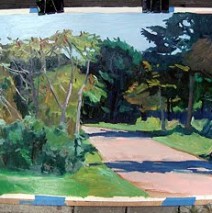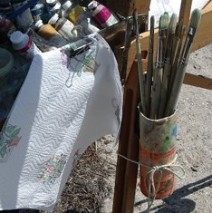Presenting one’s work
I recently had a wonderful tour of the Frames Conservation Department at the Tate, where Alastair Johnson explained many of the processes that go into the restoration of antique frames as well as the creation of new frames for museum works. For an overview of how a frame is constructed (I think maybe I always thought maybe they were just extruded, like Play-Doh), take a look at this article.
It did remind me, though, how a really inappropriate frame can detract from a painting, and how a very good one can enhance it. And gold frames do not an Old Master make. Because it’s a pretty ubiquitous contemporary aesthetic, and also for reasons of economy, I’ve always used extremely simple light-colored frames. I wonder: if I really experimented to find exactly what kind of frame might most enhance my work without overpowering it, what would it be? And could I make it myself? Creating a new frame using the techniques of the past looked like a lot of fun. You could do a lot with wood and molding from the lumber store, carpenter’s glue, some clamps, and a miter saw.
It’s often easy to see when something is poorly or inappropriately presented, but studying the painting that is quietly and harmoniously supported by its frame may give some clues about how to best present one’s own work. A big question to ponder.
Read MoreCleaning up
Here’s today’s painting, to be continued in the studio. I hate cleaning brushes, and today I found a new way to clean them that was really cheap and quick. I bought a bar of Fels Naphtha soap — the kind my mother used to rub on my father’s shirt collars before laundering them — and tried it on the brushes, which had simply been wiped with a rag. The paint came out easily, and the bristles were clean and soft when dry. It will be interesting to see what kind of long-term effect it has on the brushes, but so far it’s encouraging.
Read MoreOutdoor painting #3 – more gizmos
This isn’t an outdoor painting gizmo per se, but it is definitely one of the most money-saving devices I’ve used – a tube wringer. Gets those last bits out of that expensive tube of cobalt blue very well. They can be purchased from numerous art supply companies and also at tubewringer.com. Opt for the heavy duty one – works best on those fat tubes of white paint. Here’s the outdoor painting part: when your tube is half empty, reserve it for your outdoor painting kit. Full tubes of most paints are rarely needed, unless you paint like Van Gogh, and you’ll carry less weight.
For small plastic containers for transporting solvents, try urine specimen containers. I discovered a barrel of these at a surplus place labeled: “Urine Specimen Jars – 6 / $1.00 – Never Been Used”. Check out the fit of the lid if possible; hopefully they are leakproof for all purposes.
Read MoreOutdoor painting #2 – easels
Since I teach workshops, I am asked for easel recommendations. There is never an easy answer. Do you like to stand or sit while painting? How much can you carry comfortably? Would it be uncomfortable for you to bend frequently while painting? For me, the best solution to date has been the classic Jullian half-box French easel, because: 1.) it’s stable; 2.) I like the drawer at waist height; 3.) the hardware is good (no wing nuts that fly off or latches that pop springs, as in some other brands), and 4.) it allows me to carry a few panels/canvases on the front with ease. I put most of the weight (paint tubes, brushes) into my backpack, and added a better shoulder strap. The recent Jullians have given up the metal drawer in favor of a wooden one — not an improvement in my book. Other options of interest are the aluminum Soltek (expensive), the Anderson with a nifty swivel so you can turn your painting out of the sun, and for lightweight, the Winsor & Newton Bristol. All have their pros and cons. If anyone has discovered The Perfect Easel out there, let me know!
Read More

